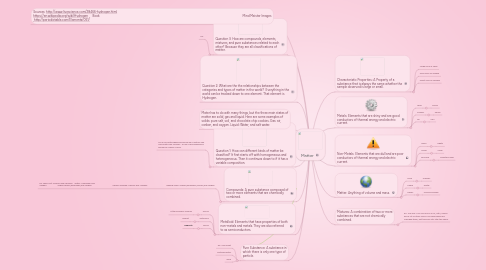Matter
by Isabel Mixis-Laird


1. Compounds: A pure substance composed of two or more elements that are chemically combined.
1.1. Ex. Table Salt: Sodium and chlorine. Water: Hydrogen and oxygen. Sugar:Carbon,hydrogen,and oxygen. Carbon Dioxide: Carbon and oxygen. Baking Soda: sodium,hydrogen,carbon,and oxygen
2. Pure Substance: A substance in which there is only one type of particle.
2.1. EX: Iron skillet
2.2. Distilled Water
2.3. Gold
3. Metalloid: Elements that have properties of both non-metals and metals. They are also referred to as semiconductors.
3.1. silicon
3.1.1. Little Neckless Charms
3.2. Antimony
3.2.1. Goblet
3.3. Boron
3.3.1. Magnets
4. Question 1: How can different kinds of matter be classified? It first starts off with homogeneous and heterogeneous. Then it continues down to if it has a variable composition.
4.1. An ex for heterogeneous would be a mixture like chocolate chip cookies. An ex of homogeneous would be a glass of milk.
5. Mater has to do with many things, but the three main states of matter are solid, gas and liquid. Here are some examples of solids: pure salt, soil, and chocolate chip cookies. Gas: air, carbon, and oxygen. Liquid: Water, and salt water.
6. Question 2: What are the the relationships between the categories and types of matter in the world? Everything in the world can be tracked down to one element. That element is Hydrogen.
7. Question 3: How are compounds, elements, mixtures, and pure substances related to each other? Because they are all classifications of matter.
7.1. EX:
8. Sources: http://www.livescience.com/28466-hydrogen.html https://en.wikipedia.org/wiki/Hydrogen , Book Mind Meister Images ,http://periodictable.com/Elements/051/
9. Mixtures: A combination of two or more substances that are not chemically combined.
9.1. EX: Trail mix. You can mix M & Ms, nuts, raisins and a lot of other food. You have physically changed them, but they will still stay the same.
10. Metals: Elements that are shiny and are good conductors of thermal energy and electric current.
10.1. Lead
10.1.1. Pencil
10.2. Copper
10.2.1. Penny
10.3. Tin
10.3.1. Can
11. Matter: Anything of volume and mass.
11.1. Solid
11.1.1. Glasses
11.2. Liquid
11.2.1. Water
11.3. Gases
11.3.1. Carbon Dioxide
12. Non-Metals: Elements that are dull and are poor conductors of thermal energy and electric current.
12.1. Neon
12.1.1. Lights
12.2. Sulfur
12.2.1. Soap
12.3. Bromine
12.3.1. Mountain Dew

